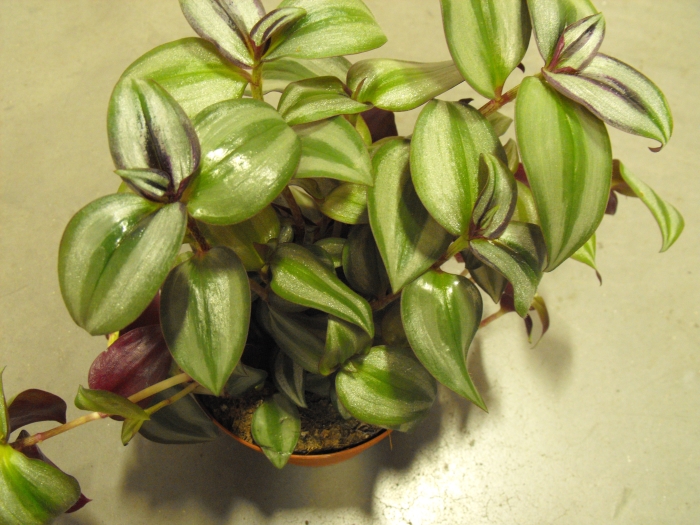Tradescantia zebrina (inch plant) is the most striking indoor foliage plant. It is also a fast-growing tropical plant with iridescent purple and silvery leaves. Tradescantia zebrina leaves turning yellow and brown are the common problems.
So, why are the leaves on my tradescantia zebrina turning yellow? Wandering Jew leaves turning yellow are due to overwatering, under-watering, nutritional deficiency, low sunlight, extreme temperatures, low humidity, and pest infestations.
Yellow tradescantia zebrina leaves are due to many reasons. The information in this article will help you identify the exact cause and tips for fixing it. Read through until the end to find the causes and solutions for inch plant leaves turning yellow.
You May Also Like: How to Care for Areca Palm

Reasons for Tradescantia Zebrina Yellow Leaves
Under-watering
Tradescantia zebrina thrives in slightly moist potting soil. The moisture content helps this indoor foliage plant stay healthy and alive throughout the year.
Dry potting soil is likely to harm your inch plant. The indoor foliage plant will decline in growth, with many lower leaves yellowing and browning.
Soak the potting mix to rehydrate the foliage plant and combat the yellow leaves. Use distilled water or rainwater to soak the potting soil.
Always inspect the soil moisture content before watering the inch plant. Tradescantia zebrina utilizes more water during spring and summer.
Overwatering
Tradescantia zebrina prefers an evenly moist potting mix. These indoor foliage plants are sensitive to an extreme when it comes to soil moisture.
A damp environment will make the inch plant start drooping and developing yellow leaves. It is usually due to a root rot problem.
Always insert the index finger in the potting soil to judge the moisture content. I recommend watering the foliage plant if 2-3 inches of topsoil is dry.
Use a pot with drainage holes at the bottom to eliminate excess water. Relocate the plant to a spot receiving indirect sunlight to encourage evaporation of excess soil moisture.
Improper Lighting
These indoor foliage plants are versatile when it comes to sunlight. Dim light conditions will fade the beautiful stripes in the foliage and cause leggy growth.
Tradescantia zebrina direct sunlight will scorch the leaves. Besides that, you will notice tradescantia leaves turning brown in the long run.
Put this foliage plant near the window to receive bright indirect sunlight. It will encourage compact growth and maintain the beautiful foliage colorations.
Early morning or late evening direct sunlight exposure will be beneficial to your indoor foliage plant. I recommend 2-3 hours to avoid harming your inch plant.
Low Humidity
Tradescantia zebrina loves a warm and humid environment. These foliage plants perform well in a humidity range of 45-65%. Low humidity will cause yellow and brown leaves.
Misting the leaves will help prevent tradescantia zebrina from dying. I recommend moving your wandering Jew to the bathroom to enjoy high humidity.
Another excellent option is to use an electric humidifier to boost indoor humidity. The high humidity level with proper ventilation will help combat the yellow leaves.
Nutritional Deficiency
Inch Plant is a tropical foliage plant that requires minimal nutrients to thrive. Fertilizer applications supply nitrogen, iron, and magnesium to the plant.
Nutritional deficiency will cause leaf discoloration. Always check the soil nutrients if your inch plant leaves start turning yellow.
I recommend the use of balanced fertilizer or organic fertilizer for houseplants. It will help increase the potting soil fertility and nourish your houseplant.
Pest Infestation
Tradescantia zebrina plants are less vulnerable to insect infestations. But it does not imply that these foliage plants are invincible to pests.
Scales and mealybugs inject the leaves with venom. It causes an infection that results in yellow and wilted leaves. Inspect the leaves underside to confirm the pest presence.
Rub alcohol on the infected leaves or neem spray to eradicate the pests. Keep your inch plant clean and healthy in a spot with bright indirect sunlight.
Natural Aging Process
Yellow leaves on tradescantia zebrina can be due to the aging process. Old leaves occur on the lower level and need to be trimmed to conserve energy.
There is no need to freak since it is a natural process that is inevitable. It would be best to consider offering ultimate tradescantia zebrina care.
Prune the old or dead foliages during springtime with a sterilized hand pruner. It creates room for healthy vegetative growth.
Extreme Temperatures
Tradescantia zebrina thrives under a temperature range of 60-80oF. Drafty areas will make your inch plant leaves turn yellow and brown.
Always keep the foliage plant away from air vents, heaters, and windowsills. It will help combat tradescantia zebrina leaves turning yellow.
You May Also Enjoy: How to Care for Blue Star Fern
Related Questions
Is It Normal for Tradescantia Zebrina Leaves to Turn Yellow?
No. Tradescantia zebrina leaves turning brown or yellow are signs of underlying problems. But the natural aging process makes inch plant yellow leaves look normal.
Should I Remove the Yellow Leaves?
Yes. Trimming the yellow leaves on tradescantia zebrina will help to conserve energy. These nutrients will later encourage new growth.
Is Tradescantia Zebrina Toxic to Humans and Pets?
Yes. It is mildly toxic to humans and pets if ingested. It causes mouth and stomach irritation immediately after ingestion.
You May Also Read: How to Care for China Doll Plant
Final Thoughts
Tradescantia zebrina is a beautiful plant with purple and silvery leaves. It is a fast-growing and low-maintenance houseplant. It is also known as inch plant or wandering jew.
The fast speed growth and foliage colors can create magic in your living space décor. It would be best to exercise ultimate tradescantia zebrina care to keep your plant happy.
Tradescantia zebrina leaves turning yellow can be alarming. I hope the information in this article will help identify the causes and solutions.
